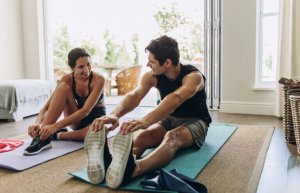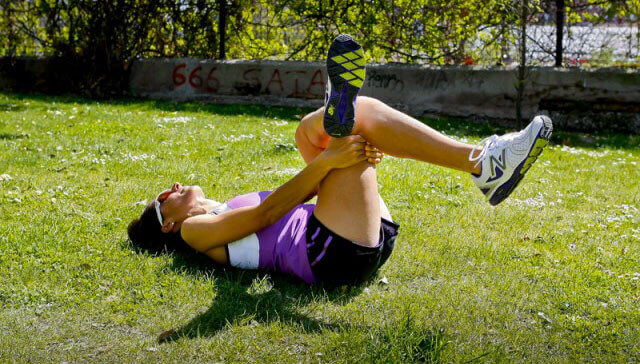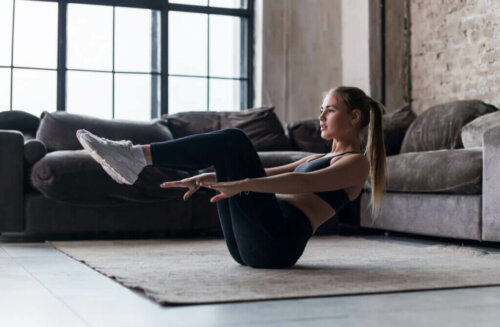Practice Stretching at Home in Order to Stay Active

For both athletes and those who work out on a regular basis, it’s important to find balance within your training plan. And part of finding this balance involves stretching–a fundamental part of any physical routine. Today, we’ll tell you how to practice stretching at home and stay active even when you must modify your training program.
In today’s article, you’ll discover what stretching consists of and analyze its importance within athletic planning. At the same time, we’ll look at a series of stretching exercises that you can do at home without the need for any additional equipment.
What is stretching?
When we talk about stretching, we’re referring to an essential habit that you should practice before and after any intense training session.
The objective here is to stretch the muscles involved in order to increase the flexibility of your muscle groups. If you include stretching when warming up, then you should do so after performing a series of articular mobility exercises. You shouldn’t carry them out as the first part of your session.
Now, if you’re planning on stretching after you’ve finished training, the objective will be different. The purpose of stretching at the end of your training session is to help your muscles return to their natural state after an intense workout. At the same time, stretching has a great preventative capacity as well. It can reduce the rate of injury among athletes when they stretch properly (Gremion, 2005).
The importance of breathing when stretching at home
One of the components of stretching is the control over your breathing. Being aware of your breathing and controlling it helps make your movements more fluid. What’s more, this should always be a pleasant activity and never reach your pain threshold, as you’ll see below.
Key tips for stretching at home
First of all, it’s important to point out that each stretching session should last no longer than 25 minutes. In fact, 20 minutes is enough. You should maintain a calm and relaxing environment at all times. The keys to this training method are as follows:
- Focus on maintaining proper control of your movements. Just as we mentioned above, it’s best to stretch for 20 minutes, attempting at all times to hold each exercise for 20 to 30 seconds, approximately. Avoid abrupt movements, as the sudden stretching of muscles can lead to injury. What’s more, holding your stretches in a stationary position will help to increase your range of motion. (Power, Behm, Cahill, Carroll & Young, 2004).
- Possess good posture control. Maintaining a good posture while you practice stretching is fundamental when it comes to avoiding the risk of injury. Be sure to relax your shoulders and always look forward. At the same time, maintain a neutral pelvic position.
- Avoid reaching your pain threshold. You should avoid experiencing pain during your stretches. Offer just enough resistance to meet the objective of stretching your muscles, but not to the point that it hurts.
What exercises can you utilize when stretching at home?
Below, we’ll offer a series of very simple exercises that don’t require any additional equipment:
- A good exercise to start with is to stand up with your legs apart and your arms stretched straight up. Breathe in and then exhale as you lower your arms and relax.
- Then, sit down on an exercise mat. From this position, hold onto one ankle with one hand and the outer part of your leg with the other. Hold this position for between 20 and 30 seconds.
- For the following movement, you’ll remain seated. Now, stretch your arms as far as you can and remain in this position, as upright as possible.
- In the following exercise, you should lie down on your exercise mat, face-up, with your knees bent. Then, raise one leg, placing it on top of the other, pushing it toward the floor.

- Stretching your abdomen or your core muscles is also fundamental. To do so, turn over face-down on your mat. Then, slowly raise your torso and hold this position.
- In order to finish, you should stand up once again. Grab onto your right leg with your knee flexed behind you, maintaining your balance at all times. Then, repeat the exercise with your left leg.
An ideal activity for staying active
As you’ve been able to observe, stretching at home is a very simple activity that we should all include in our training routines. There are a number of stretching exercises that you can apply with this method, depending on the muscles you used while training.
In order for your efforts to be effective, you should keep in mind the key tips we outlined at the beginning. Remember the importance of avoiding any type of pain while performing this activity.
For both athletes and those who work out on a regular basis, it’s important to find balance within your training plan. And part of finding this balance involves stretching–a fundamental part of any physical routine. Today, we’ll tell you how to practice stretching at home and stay active even when you must modify your training program.
In today’s article, you’ll discover what stretching consists of and analyze its importance within athletic planning. At the same time, we’ll look at a series of stretching exercises that you can do at home without the need for any additional equipment.
What is stretching?
When we talk about stretching, we’re referring to an essential habit that you should practice before and after any intense training session.
The objective here is to stretch the muscles involved in order to increase the flexibility of your muscle groups. If you include stretching when warming up, then you should do so after performing a series of articular mobility exercises. You shouldn’t carry them out as the first part of your session.
Now, if you’re planning on stretching after you’ve finished training, the objective will be different. The purpose of stretching at the end of your training session is to help your muscles return to their natural state after an intense workout. At the same time, stretching has a great preventative capacity as well. It can reduce the rate of injury among athletes when they stretch properly (Gremion, 2005).
The importance of breathing when stretching at home
One of the components of stretching is the control over your breathing. Being aware of your breathing and controlling it helps make your movements more fluid. What’s more, this should always be a pleasant activity and never reach your pain threshold, as you’ll see below.
Key tips for stretching at home
First of all, it’s important to point out that each stretching session should last no longer than 25 minutes. In fact, 20 minutes is enough. You should maintain a calm and relaxing environment at all times. The keys to this training method are as follows:
- Focus on maintaining proper control of your movements. Just as we mentioned above, it’s best to stretch for 20 minutes, attempting at all times to hold each exercise for 20 to 30 seconds, approximately. Avoid abrupt movements, as the sudden stretching of muscles can lead to injury. What’s more, holding your stretches in a stationary position will help to increase your range of motion. (Power, Behm, Cahill, Carroll & Young, 2004).
- Possess good posture control. Maintaining a good posture while you practice stretching is fundamental when it comes to avoiding the risk of injury. Be sure to relax your shoulders and always look forward. At the same time, maintain a neutral pelvic position.
- Avoid reaching your pain threshold. You should avoid experiencing pain during your stretches. Offer just enough resistance to meet the objective of stretching your muscles, but not to the point that it hurts.
What exercises can you utilize when stretching at home?
Below, we’ll offer a series of very simple exercises that don’t require any additional equipment:
- A good exercise to start with is to stand up with your legs apart and your arms stretched straight up. Breathe in and then exhale as you lower your arms and relax.
- Then, sit down on an exercise mat. From this position, hold onto one ankle with one hand and the outer part of your leg with the other. Hold this position for between 20 and 30 seconds.
- For the following movement, you’ll remain seated. Now, stretch your arms as far as you can and remain in this position, as upright as possible.
- In the following exercise, you should lie down on your exercise mat, face-up, with your knees bent. Then, raise one leg, placing it on top of the other, pushing it toward the floor.

- Stretching your abdomen or your core muscles is also fundamental. To do so, turn over face-down on your mat. Then, slowly raise your torso and hold this position.
- In order to finish, you should stand up once again. Grab onto your right leg with your knee flexed behind you, maintaining your balance at all times. Then, repeat the exercise with your left leg.
An ideal activity for staying active
As you’ve been able to observe, stretching at home is a very simple activity that we should all include in our training routines. There are a number of stretching exercises that you can apply with this method, depending on the muscles you used while training.
In order for your efforts to be effective, you should keep in mind the key tips we outlined at the beginning. Remember the importance of avoiding any type of pain while performing this activity.
This text is provided for informational purposes only and does not replace consultation with a professional. If in doubt, consult your specialist.








